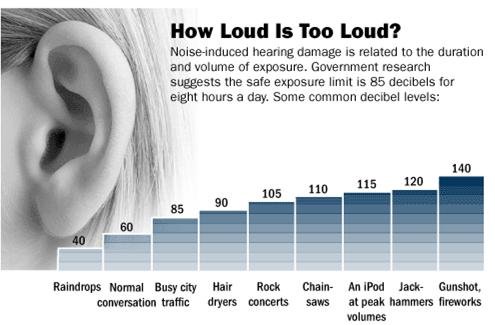Working with power tools is a necessary part of many trades, from construction and carpentry to mechanics and manufacturing. However, these tools, while essential for getting the job done, also come with the risk of damaging your hearing due to the loud noises they produce. Prolonged exposure to high decibel levels can lead to permanent hearing loss, a common problem in noisy work environments. Understanding the decibel levels of the power tools you use and taking the necessary steps to protect your hearing is crucial for both short-term comfort and long-term health.
What Are Decibels?
Decibels (dB) are a unit of measurement used to express the intensity of sound. The decibel scale is logarithmic, meaning that every increase of 10 dB represents a tenfold increase in sound intensity. Sounds at or above 85 dB can cause hearing damage over time, especially when exposure is prolonged. A decibel chart helps us better understand these different levels, comparing various sounds from the quietest whispers to the roar of an industrial saw.
The Decibel Levels of Power Tools
To protect your hearing, it’s important to know the decibel levels of the power tools you’re using on a daily basis. Here are some common power tools and their approximate sound levels:
- Drill (85-95 dB) A standard electric drill can produce a noise level between 85 and 95 dB. While it’s generally safe for short periods of use, prolonged exposure to this noise without ear protection can cause hearing damage. If you’re using a drill for an extended period, consider wearing earplugs or earmuffs to protect your hearing.
- Circular Saw (90-110 dB) Circular saws are one of the most common power tools in woodworking and construction. They can produce noise levels between 90 and 110 dB, depending on the model and the material being cut. At this level, hearing protection is essential, especially when working with the saw for long periods. A continuous exposure to noise at or above 85 dB can result in permanent hearing loss.
- Jackhammer (110-130 dB) Jackhammers are used in construction, demolition, and roadwork, and their noise levels can range from 110 to 130 dB. This level is considered extremely loud and can cause immediate hearing damage. Protective earplugs or earmuffs are a must for workers who regularly use this tool.
- Chainsaw (100-120 dB) Chainsaws are powerful tools often used in forestry, landscaping, and construction. They can generate noise levels between 100 and 120 dB, depending on the type and size of the saw. Like other loud power tools, chainsaws require hearing protection to prevent long-term hearing damage.
- Angle Grinder (90-115 dB) Angle grinders are frequently used in metalworking and construction for cutting, grinding, and polishing. These tools can produce noise levels from 90 dB up to 115 dB, depending on the material being worked on and the tool’s motor size. Exposure to these sound levels without ear protection is dangerous, as prolonged noise exposure at these levels can cause permanent damage to your hearing.
- Impact Wrench (95-105 dB) Impact wrenches, which are commonly used in automotive repair and construction, can create noise levels between 95 and 105 dB. These tools are particularly loud when performing high-torque tasks, such as tightening bolts. Like all loud power tools, ear protection is crucial when using an impact wrench for extended periods.
- Air Compressor (85-95 dB) Air compressors are widely used in industrial settings for powering pneumatic tools. The noise level generated by an air compressor can range between 85 and 95 dB. Though on the lower end of the spectrum for power tools, exposure to this sound for long periods still requires ear protection to prevent hearing loss.
The Risk of Hearing Damage
Exposure to sounds over 85 dB can lead to hearing damage, and the risk increases with both the intensity and duration of the exposure. For instance, if you work in a noisy environment with power tools regularly, the sound levels can accumulate and significantly increase the risk of hearing loss.
Hearing damage is often gradual, making it difficult to notice in the early stages. However, once hearing loss occurs, it is usually permanent. Some symptoms of hearing damage include muffled hearing, ringing in the ears (tinnitus), and difficulty understanding speech, especially in noisy environments.
The Occupational Safety and Health Administration (OSHA) sets guidelines for occupational noise exposure, recommending that workers should not be exposed to sounds above 85 dB for more than 8 hours a day. For every 3 dB increase in sound level, the safe exposure time is halved. For example, if you’re exposed to 88 dB, the safe exposure time is 4 hours.
Protecting Your Hearing
Given the loud decibel levels of power tools, taking steps to protect your hearing is essential. Here are some effective strategies:
- Wear Hearing Protection Earplugs or earmuffs should be worn whenever you’re working with power tools that generate noise levels over 85 dB. While earplugs are good for blocking out high-pitched sounds, earmuffs offer more overall sound protection and comfort during prolonged use.
- Limit Exposure If possible, take breaks from loud work environments to give your ears time to recover. Reducing the time spent in noisy areas can help lower the risk of hearing damage.
- Use Noise Barriers Whenever feasible, consider using noise barriers or enclosures for tools, particularly in larger industrial settings. These can help reduce the overall noise exposure for you and your coworkers.
- Regular Hearing Checks Schedule regular hearing tests to monitor your hearing health. Early detection of hearing loss can help you take the necessary steps to prevent further damage.
- Maintain Tools Ensure your power tools are well-maintained and functioning properly. Faulty or poorly maintained tools often produce louder noises, which can increase the risk of hearing damage.
Conclusion
Power tools are essential for many jobs, but they come with the potential risk of hearing damage. By understanding the decibel levels of different tools and taking appropriate measures to protect your hearing, you can prevent long-term damage. Always wear hearing protection, limit exposure to loud environments, and maintain your tools to ensure your hearing stays intact. By being proactive, you can safeguard your health and continue to work safely in a noisy environment.

